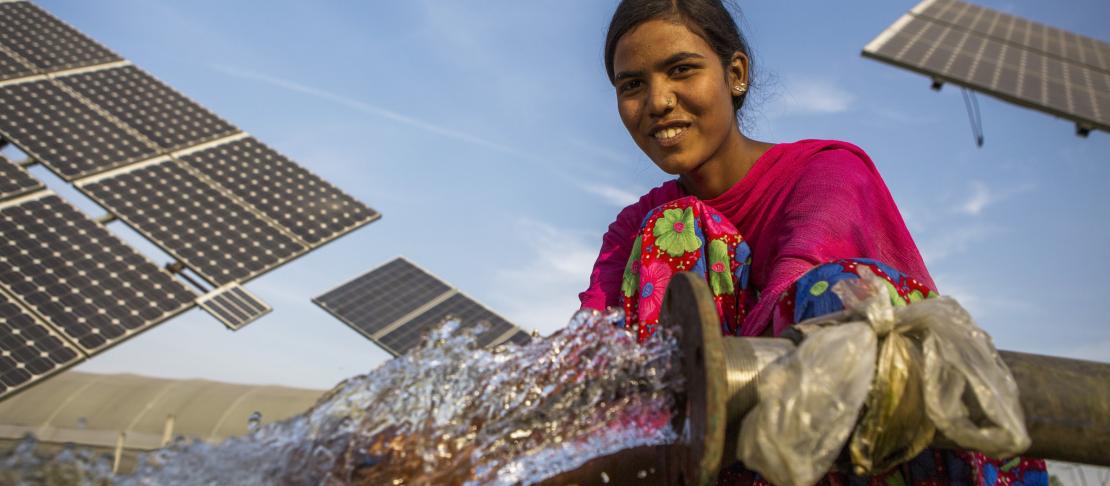Why India’s leap into the solar-powered age must take along farmers

Growing solar energy sounds radical but the gains from making farmers active players in the renewable energy market, rather than mere recipients of government subsidies, could be a real game changer for climate-smart agriculture.
India is looking towards the sun. Answers to some of the country’s most pressing energy and climate change issues could lie in the enviable 300 sunny days a year that many parts of the country enjoy.
If domestic enthusiasm for Indian Prime Minister Narendra Modi’s solar energy policy is already high, international partners are on board too. US President Obama on his recent visit to India said: “We stand ready to speed this advancement with additional financing.”
Right now the country is running on coal. Solar energy constitutes a mere 1 percent of the energy mix. The government’s ambitious solar energy targets aim to raise this to about 100,000 megawatts by 2020 - that is about 10 percent of the energy mix.
The question is how and where this solar power will be generated? A popular option is rooftop solar panels as in North America and Europe or setting up rural micro-grids. But in terms of scale, about 80 percent of the solar energy will be generated in megawatt power plants. Setting up these plants requires considerable amount of land, which will have to acquired at a cost, and the money from this will not trickle down to the poor.
What if farmers can set up solar panels on their farmland and sell the excess power they generate back to the grid? This could rejuvenate the lagging-behind farm sector and augment the incomes of millions of farmers.
Solarising the farm sector ...
- Solar power constitutes one percent of the energy mix. Ambitious targets aim to make this 10 percent by 2020.
- Solar power can become a remunerative 'cash crop' for farmers.
- Solar-powered pump-sets can phase out diesel- guzzling pumps and cut India's emissions from the farm sector by 6 percent
- IWMI researchers have proposed SPARC- Solar Power As A Remunerative Crop.
At the International Water Management Institute (IWMI), we outline how farmers can ride this new solar energy wave
to see sustained benefits from the government’s solar mission strategy. Farmers must be proactive players from the onset and not merely passive recipients of government subsidies. If agriculture is to become truly resilient and climate-smart, it should improve productivity, ensure steady incomes, save water and cut emissions.
Solar Power As a Remunerative Crop (SPARC) proposes 'growing solar power’ as a renumerative 'crop'. As radical as this sounds, it could usher in a new generation of farmer-entrepreneurs. It essentially means incentivising farmers to generate solar energy on their farm land, use some energy to power their pumpsets, and sell the rest back to the grid. CCAFS is supporting this project with IWMI to validate this climate-smart agriculture practice in the field in India.
Solar (em)powered farmlands
India today has around 18 million grid-connected pumpsets and 7 million diesel pumpsets. For a farmer, higher yeilds (and income) hinges on reliable irrigation. Erratic power supply and huge diesel costs are still major obstacles.
A solar plant can guarantee around 2500 hours a year of quality day-time power free of cost. Many states in India have solar pump subsidy schemes as part of ‘green energy’ schemes. But the availability of a steady and (almost) free supply of power risks the overuse of pumps. In many places, groundwater has been stretched to its limits. Depleting aquifers undo all the ‘green goodness’ of solar pumps.
Getting clean: replacing grid-powered pumps with solar ones
To augment their incomes, farmers have typically looked at diversifying their crop basket with fruits, vegetables or cash crops. But the gains from setting up a solar plant on their farms and selling the energy could be significant.
To make this viable, the government will have to phase out the hugely subsidised electricity provided to the farm sector. Subsidies have put an enormous burden on the grids. To see the benefits of SPARC-enabled pumps, solar pumps will need to completely replace grid-powered pumps. This will ensure that energy is used responsibly and the surplus has real market value. By saving energy, preventing the overexploitation of groundwater through indiscriminate pumping and promoting a clean energy source, SPARC-enabled pumps can cut the carbon footprint of our agriculture.
India’s 11 million electric tubewells use an estimated 117 billion units of electricity every year and emit 110 million metric tons of carbon dioxide into the atmosphere. In addition, 9 million diesel pumps burn some 7 billion litres of diesel for irrigation every year and emit additional 20 million metric tons of carbon dioxide. By solarising our groundwater economy, we can curtail India’s annual carbon dioxide emissions by nearly 6 percent.
Give farmers purchase guarantees instead of subsidies
A 10-kilowatt solar plant on a farm can generate up to 13,000 units of power worth INR 1,00, 000 (1700 USDS) a year on just 1/25th of a hectare. Since sunlight, the only input required, is free of cost all revenue is net income. Once installed, a solar plant is a cash cow and the returns from the input costs can be realised in a few years. Instead of subsidising electricity, a policy that ensures a purchase guarantee on solar energy from farmers could be a way to resurrect the agrarian sector.
There are of course factors that should be in place to make SPARC a success.
A conducive institutional and policy environment is necessary for a good start. It needs to become an intergral part of the National Solar Mission. Further, cooperatives will need to be formed so farmers can collectively sell power to the electricty companies to reduce tranbscation costs from too many dispersed individual sellers.
Tushaar Shah is a Senior Fellow at the International Water Management Institute (IWMI). This story was written by Dharini Parthasarathy, Communications Specialist, CCAFS South Asia



